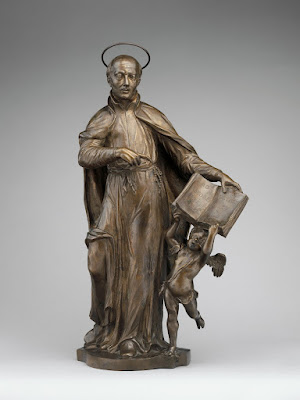 |
| Julian Schnabel Ignatius of Loyola 1987 oil on canvas Museum Ludwig, Cologne |
 |
| Gérard Audran after Peter Paul Rubens Three Demons beating St Ignatius Loyola ca. 1680 etching British Museum |
 |
| Francesco Bertos St Ignatius Loyola ca. 1722 bronze statuette Metropolitan Museum of Art, New York |
-Art-Institute-of-Chicago.jpg) |
| Elias Christoph Heiss after Andreas Wolff St Ignatius Loyola 1696 mezzotint (thesis sheet) Art Institute of Chicago |
 |
| Domenico Zampieri Christ and God the Father at La Storta (Vision of St Ignatius Loyola) ca. 1622 oil on canvas Los Angeles County Museum of Art |
 |
| Domenico Piola Christ and God the Father at La Storta (Vision of St Ignatius Loyola) ca. 1690-1700 drawing Museum Kunstpalast, Düsseldorf |
 |
| Andrea Pozzo Triumph of St Ignatius Loyola 1685-90 illusionistic vault fresco Chiesa di Sant' Ignazio di Loyola, Rome |
 |
| Girolamo Frezza and Arnold van Westerhout after Andrea Pozzo Triumph of St Ignatius Loyola 1702 engraving of vault fresco British Museum |
 |
| Peter Paul Rubens St Ignatius Loyola ca. 1620-22 oil on canvas Norton Simon Museum, Pasadena |
 |
| Peter Paul Rubens Miracles of St Ignatius Loyola ca. 1617-18 oil on canvas Kunsthistorisches Museum, Vienna |
 |
| Peter Paul Rubens Miracles of St Ignatius Loyola 1619 oil on panel Dulwich Picture Gallery, London |
-St-Gregory-the-Great-with-Sts-Ignatius-Loyola-and-Francis-Xavier-c1625-26-oil-on-canvas-National-Gallery-London.jpg) |
| Guercino (Giovanni Francesco Barbieri) St Gregory the Great with St Ignatius Loyola and St Francis Xavier ca. 1625-26 oil on canvas National Gallery, London |
 |
| Antonio Balestra Virgin and Child in Glory adored by St Ignatius Loyola and St Stanislaus Kostka ca. 1731 oil on canvas Pinacoteca Nazionale di Bologna |
-Crucifixion-with-Virgin-John-Evangelist-Francis-Ignatius-1637-oil-on-canvas-Collegiata-di-Santa-Maria-Maggiore-Pieve-di-Cento.jpg) |
| Bartolomeo Gennari The Crucifixion with the Virgin, St John the Evangelist, St Francis of Assisi and St Ignatius Loyola 1637 oil on canvas Collegiata di Santa Maria Maggiore, Pieve di Cento |
 |
| John Faber the Younger after Titian Portrait of Ignatius Loyola (reputed) 1755 lithograph Scottish National Gallery, Edinburgh |
-2007-lithograph-British-Museum.png) |
| Luc Tuymans Hell (as described by St Ignatius Loyola in The Spiritual Exercises) 2007 lithograph British Museum |
"The Jesuits, as we know, have contributed much to forming our notion of literature. The heirs and propagators of Latin rhetoric, through teaching, over which they had in the past, to all intents and purposes, a monopoly in Europe, they left bourgeois France with the concept of "fine writing," censure of which is still frequently confounded with the image of literary creation we set up. However, the Jesuits stubbornly deny to their founder's book this literary prestige they have helped to establish: the exposition of the Exercises is said to be "disconcerting," "curious," "bizarre"; "it is all labored," one Father writes, "literarily impoverished. The author has tried merely to provide the most just expression, the most exact transmission posible to the Society of Jesus, and thereby, to the Church, of the gift which he himself had received from God." Here we find once more the old modern myth according to which language is merely the docile and insignificant instrument for the serious things that occur in the spirit, the heart or the soul. This myth is not innocent; discrediting the form serves to exalt the importance of the content: to say: I write badly means: I think well. Classical ideology practices in the cultural order the same economy as bourgeois democracy does in the political order: a separation and balance of powers, a broad but closely watched territory is conceded to literature, on condition that the territory be isolated, hierarchically, from other domains; thus it is that literature, whose function is a worldly one, is not compatible with spirituality; one is detour, ornament, veil, the other is immediation, nudity: this is why one cannot be both a saint and a writer. Purified of any contact with the seductions and illusions of form, Ignatius's text, it is suggested, is barely language: it is the simple, neuter path which assures the transmission of a mental experience. Thus once again the place our society assigns to language is confirmed: decoration or instrument, it is seen as a sort of parasite of the human subject, who uses it or dons it at a distance, like an ornament or tool picked up and laid down according to the needs of subjectivity or the conformities of sociality."
– Roland Barthes, from Sade, Fourier, Loyola (1971), translated by Richard Miller (Hill and Wang, 1976)